Homemade vegetable broth is ridiculously cheap, easy, and the BEST way to breathe new life into veggies that have seen better days. Here’s how to make it from scraps in your Instant Pot or on the stove-top, including a special ingredient for extra umami flavor!
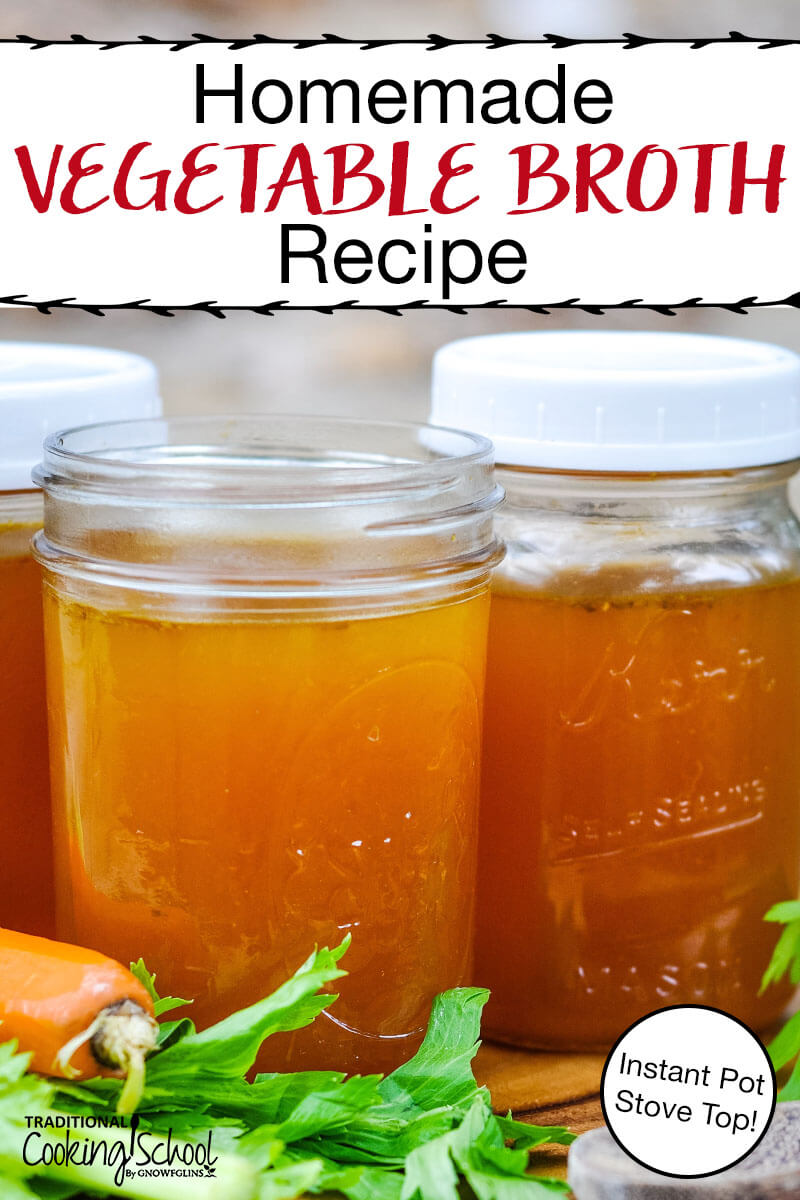
They call my husband the “frugal forager” for a reason.
He prides himself on saving a buck wherever he can. Clothes get mended instead of replaced, eggshells and coffee grounds go in the compost bin, and even leftover veggie scraps and peels are salvaged during dinner prep.
While I’m quick to throw them out, my husband cries “No!” and ensures that each scrap of veg lands safely in a special bag in the freezer.
Why, you ask?
To make homemade broth!
While our go-to is usually chicken broth or beef bone broth, I’ve recently found perpetual broth and homemade vegetable broth to be an economical and tasty alternatives. It adds wonderful flavor to a huge variety of dishes, from risotto to casserole to soups and stews.
Plus, it’s the best way to use up those freezer bags full of vegetable scraps!
Why make homemade vegetable broth? What are the benefits of vegetable soup?
Chicken, fish, or beef broths are full of wonderful nutrients, including collagen which is amazing for joints, skin, hair, and nails. We’ve all sung the praises of these types of broths time and again, such as our perpetual stock or broth.
While less popular, vegetable broth is great for you, too.
Not only is it the obvious choice for vegetarian or vegan recipes, I love the taste of all that veggie goodness which is released into the broth as it simmers. It’s also much quicker to make than bone broth.
Veggie broth is also very cheap. If you don’t have any bones on hand, making broth from veggies about to go bad or from scraps you’ve saved costs only pennies!
Plus, it’s the perfect companion to any homemade soup with veggies, including Quinoa Vegetable Soup, Creamy Fall Harvest Soup, Instant Pot Vegetable Beef Soup, Cream of Vegetable Soup, and Fava Bean Soup.
Here are 9 ways to consume more broth without drinking it straight and 5 ways to make your bone broth more exciting.
To make your veggies go even further after you make broth, you can even use the cooked, strained veggies to make your own homemade bouillon cubes!
The Easiest Vegetable Broth Recipe Hack
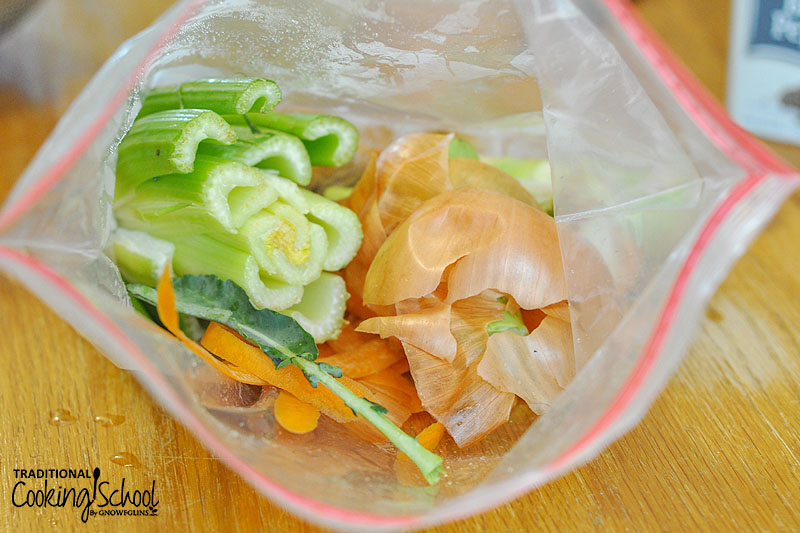
Next time you’re prepping a meal, keep a freezer bag nearby so you can toss in all your onion/garlic skins, carrot peels/tops, and the like.
If you notice any veggies hanging out in your fridge that are about to go bad, throw them in the bag, too.
Keep this bag in the freezer until ready to make broth. You need only a few fresh veggies, spices, and water to make a pot full of nourishing vegetable broth!
Obviously, this method works best when using organic veggies, as you won’t need to worry about pesticides sprayed on the food. Otherwise, you’re better off discarding the peels and skins, or washing them extremely well with a non-toxic veggie wash.
When your freezer bag is full of veggie scraps, it’s time to make broth!
How To Make Vegetable Broth (Stove Top Or Instant Pot)
This vegetable broth recipe couldn’t be simpler! It’s much tastier (and cheaper) than store-bought broth, too.
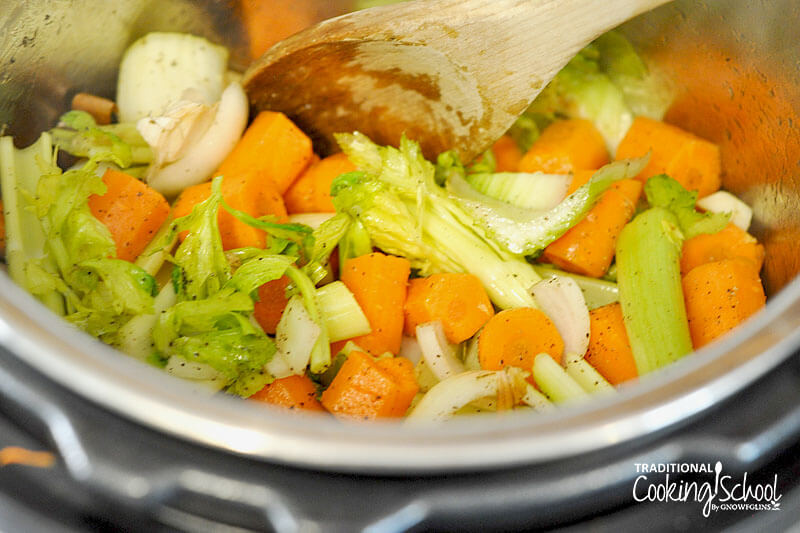
Simply saute some freshly-chopped onions, carrots, and celery (large chunks are fine) with a bit of garlic in the Instant Pot or on the stovetop. Add spices and salt, too. (Click here to find out which size Instant Pot is best for you!)
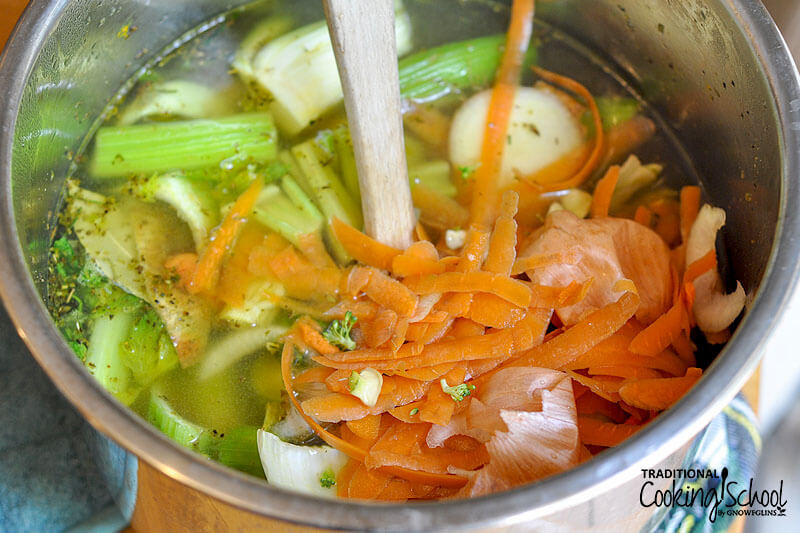
After the veggies have cooked for a few minutes, add filtered water, any extra veggie scraps you’ve saved, plus one special secret ingredient.
Ever wondered, “What is the secret to flavorful vegetable soup?”
Here it is…
Tomato paste.
Yes, tomato paste! It might seem odd, but adding tomato paste to vegetable broth adds an extra layer of flavor, or umami, to the broth that might be missing without animal bones.
Tomato paste gives this broth a rich flavor and rounds it out nicely, adding beautiful color too.
Stir the pot and bring to a boil, cover with a lid and reduce to a simmer for around an hour. If making Instant Pot vegetable broth, lock the lid in place and cook on high pressure for 20 minutes.
After your broth is done cooking, strain and pour into storage jars to use in all your favorite recipes!
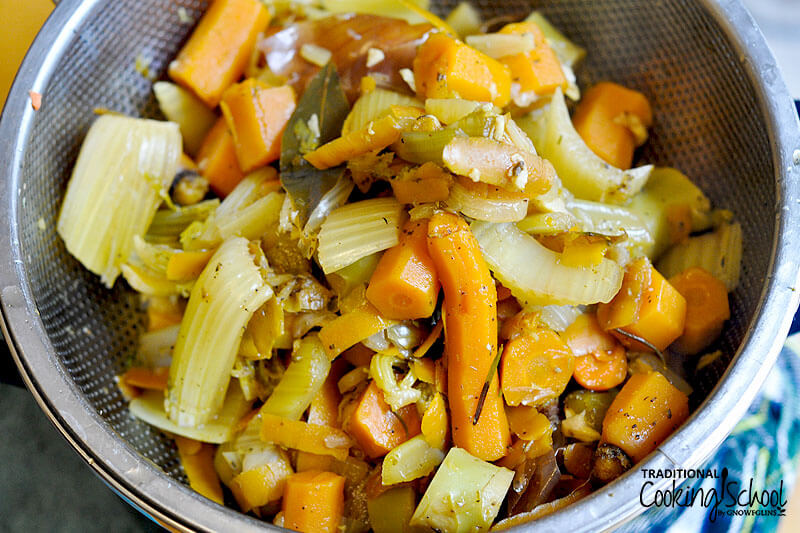
What vegetables should I add to my vegetable broth?
The classic veggies to use for vegetable broth are onions, celery, and carrots (a.k.a. mirepoix in French cooking). Plenty of garlic is always welcome, too.
But you can get creative here and add things like bell pepper, zucchini, squash, okra… the sky’s the limit! Mushrooms are another great option to add a savory flavor to the broth.
The only vegetables you might want to omit are potatoes, since these add lots of starch to the broth, yielding a gummy texture.
Apparently, using cruciferous veggies like Brussels sprouts, broccoli, and cabbage can leave a bitter taste in your veggie broth. But, I added a few broccoli stalks to this batch and it tasted great!
What seasonings should I add to veggie broth?
This vegetable broth is pretty versatile when it comes to seasonings, but I like to keep things simple. I prefer not to over-season, since the broth’s flavor profile can alter the taste of other dishes.
For this recipe, I’m using bay leaves, turmeric (for color and health-boosting properties), fresh parsley, and fresh rosemary. Thyme is another great option if you have some on hand.
If you don’t have fresh herbs, feel free to use dried.
Vegetable Stock Vs. Broth
In writing this post, I got a little confused.
What is the difference between vegetable stock and vegetable broth? Are they the same thing, or are they different?
Once source I read said that by definition, stock cannot be made without bones, thus vegetable “stock” is not a real thing. Another source said the difference lies in that stock is unsalted (which lends itself to adding to other recipes without changing the seasoning profile), while broth adds plenty of salt and seasoning.
Finally, I settled on this definition from Fine Cooking:
Stock, as a word, implies a kind of building block. Stocks are never served on their own, they are used to build other things. “Stock your pantry,” is an example of that word used in a different way. Same thing. Broth is an older word, and it essentially means something that is boiled. So, to summarize, vegetable broth and vegetable stock are the same thing.
Is that about as clear as mud now? Good. 😉
(For more information on the difference between stock and broth using meat, refer to What’s The Difference Between Stock And Broth?)
How to substitute vegetable broth for chicken broth?
You can use vegetable broth in any recipe that calls for chicken broth (or even beef broth). It adds a subtle, delicious flavor that’s less pronounced than bone broths.
Add it liberally to soup, casseroles, gravies, stews, roasts, and more.
However, if you are making a chicken dish that relies on having a strong chicken flavor, chicken broth is the best option.
What’s your favorite type of broth: vegetable, chicken, fish, or beef? Why?
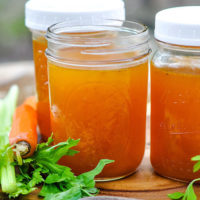
Homemade Vegetable Broth (Stove Top, Instant Pot)
Homemade vegetable broth is ridiculously cheap, easy, and the BEST way to breathe new life into veggies that have seen better days. Here's how to make it from scraps in your Instant Pot or on the stove-top, including a special ingredient for extra umami flavor!
Ingredients
- 1 tablespoon avocado oil or other high-heat oil
- 1 large onion chopped (with skins)
- 4 carrots chopped (with skins)
- 1 green bell pepper chopped
- 3 stalks celery chopped
- 5 cloves garlic chopped (with skins)
- 2 teaspoons sea salt divided
- 2 teaspoons ground black pepper divided
- 2 sprigs fresh rosemary
- 1/2 cup fresh parsley
- 3 sprigs fresh thyme
- 1 teaspoon ground turmeric
- 10 to 11 cups pure water
- 2 tablespoons tomato paste
- 2 bay leaves
- 2 to 3 cups vegetable scraps any variety (thoroughly washed, optional)
Instructions
-
Heat oil on medium high in a large stock pot.
-
Add chopped onion, carrot, bell pepper, and celery.
-
Sprinkle with 1 teaspoon each sea salt and pepper.
-
Add rosemary, parsley, thyme, and turmeric.
-
Stir and saute for 5 minutes, adding garlic during last minute of cooking time.
-
To pot, add filtered water, bay leaves, tomato paste, and additional vegetable scraps (if using).
-
Stir well and bring to a boil.
-
Reduce heat to medium low, cover with a lid, and allow broth to simmer for a minimum of 30 minutes, up to 1 hour.
-
Strain broth through a large strainer into another pot.
-
Season with additional salt and pepper, to taste.
-
Pour into jars for storage.
-
Broth may be kept in the fridge up to 5 days, and can be frozen for up to 6 months.
Recipe Notes
Instant Pot method:
- If using an electric cooker such as the Instant Pot, press the "Saute" function. If using a stove-top cooker, place on burner over medium heat.
- Add chopped onion, carrot, bell pepper, and celery.
- Sprinkle with 1 teaspoon each sea salt and pepper.
- Add rosemary, parsley, thyme, and turmeric.
- Stir and saute for 5 minutes, adding garlic during last minute of cooking time.
- Turn off (if electric cooker) or leave on the stove (if stovetop cooker).
- To the insert pot, add water, bay leaves, tomato paste, and additional vegetable scraps (if using). Stir.
- Cover the pot, checking the seal and components to make sure all is well.
- If using an electric cooker, set to high pressure for 20 minutes. If using a stove-top cooker, bring to high pressure and maintain for 20 minutes.
- When cycle is complete, turn off (if electric cooker) or remove from heat (if stovetop cooker).
Quick release pressure, or let it sit to release pressure naturally. - Strain broth through a large strainer into another pot.
- Season with additional salt and pepper to taste.
- Pour into jars for storage.
- Broth may be kept in the fridge up to 5 days, and can be frozen for up to 6 months.
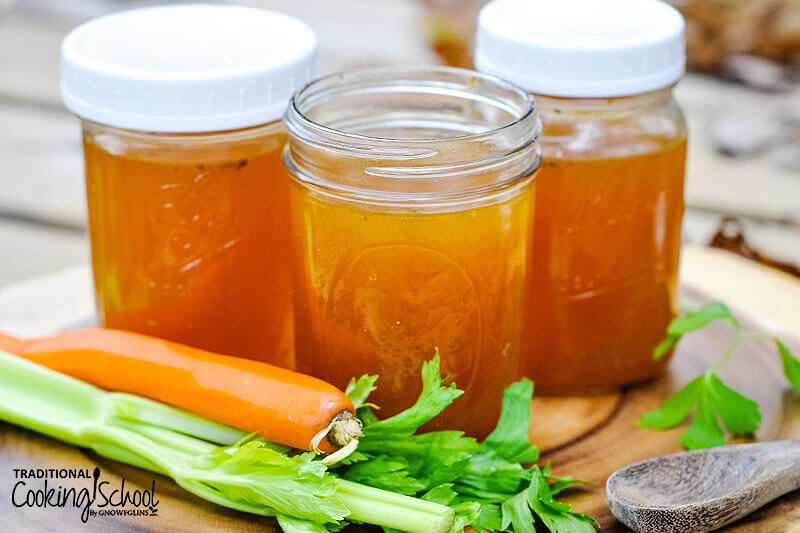
Do you make homemade broth or stock?
...without giving up the foods you love or spending all day in the kitchen!

2 free books:
Eat God's Way
Ditch the Standard American Diet, get healthier & happier, and save money on groceries...
We only recommend products and services we wholeheartedly endorse. This post may contain special links through which we earn a small commission if you make a purchase (though your price is the same).


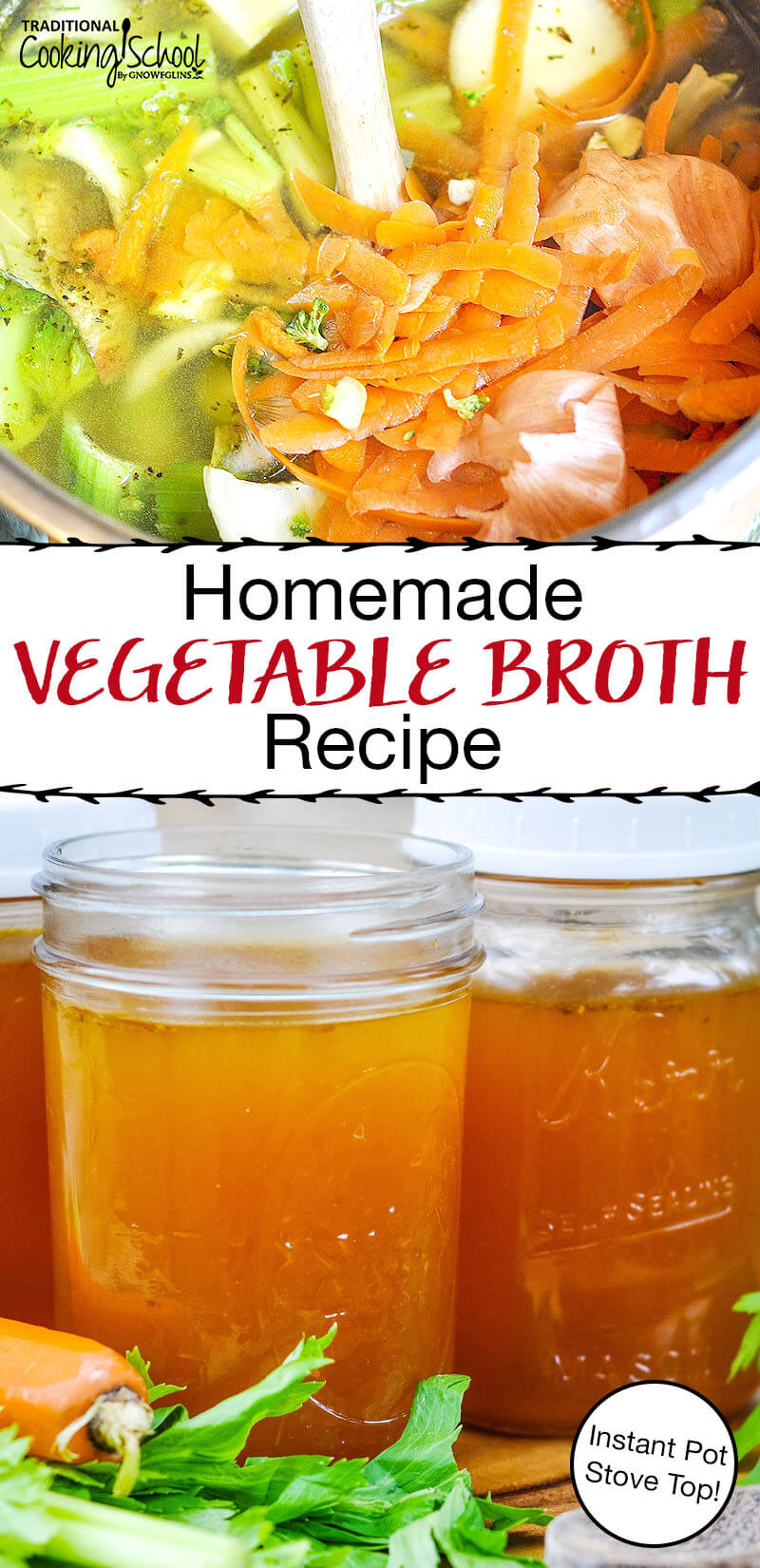
My veg scraps usually go into the compost bin BUT I think it is worthwhile to ‘stock’ up on the scraps until I have enough to make the stock. I used to do this when I lived in apartments with little or no room for compost. also, I save water that vegies are cooked in by ice cube trays, Little goes to waste in my house!
Those are great ideas Karen! Being frugal is so helpful!
Instead of tomato paste can you use 1/2 cup of home canned tomato juice?
You sure can Marcia! The taste may differ slightly, but not much.
I’ve had scrap bags in the freezer for years, both vegetable and chicken bones. A bag of scraps + a bag of bones = free to me chicken broth and a bag of scraps alone = free to me vegetable broth. I had never heard of the tomato paste idea but I will have to try that! A tomato paste tip I use: When opening a can of tomato paste, scoop it into tablespoon drops on parchment paper and freeze, then transfer to a jar (or bag) in my freezer. You can easily pull out 1 or 2 frozen spoonfuls as needed for recipes. Love your blog!
That is a great tip about storing tomato paste Angelina! Going to have to try it! Thank you.
What vegetable scraps should one not use to make a vegetable broth? I think I read somewhere not to use potato skins.